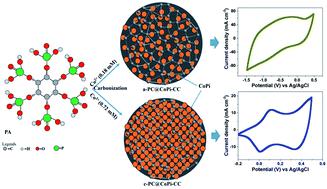当前位置:
X-MOL 学术
›
Nanoscale Adv.
›
论文详情
Our official English website, www.x-mol.net, welcomes your
feedback! (Note: you will need to create a separate account there.)
Phytic acid controlled in situ synthesis of amorphous cobalt phosphate/carbon composite as anode materials with a high mass loading for symmetrical supercapacitor: amorphization of the electrode to boost the energy density
Nanoscale Advances ( IF 4.6 ) Pub Date : 2020-09-09 , DOI: 10.1039/d0na00670j Taewoo Kim 1 , Arjun Prasad Tiwari 1, 2 , Kisan Chhetri 1 , Gunendra Prasad Ojha 1 , Hyoju Kim 1 , Su-Hyeong Chae 1 , Bipeen Dahal 1 , Byoung Min Lee 3 , Tanka Mukhiya 1 , Hak Yong Kim 1, 4
Nanoscale Advances ( IF 4.6 ) Pub Date : 2020-09-09 , DOI: 10.1039/d0na00670j Taewoo Kim 1 , Arjun Prasad Tiwari 1, 2 , Kisan Chhetri 1 , Gunendra Prasad Ojha 1 , Hyoju Kim 1 , Su-Hyeong Chae 1 , Bipeen Dahal 1 , Byoung Min Lee 3 , Tanka Mukhiya 1 , Hak Yong Kim 1, 4
Affiliation

|
Transition metal phosphate (TMPi)-based composites as anode electrode materials in supercapacitor applications are less reported. Herein, we report a phytic acid (PA)-assisted in situ-formed amorphous cobalt phosphate/carbon (CoPi/C) composite grown on a flexible woven carbon cloth (CC) via a simple one-step carbonization approach. The tunable synthesis of amorphous and crystalline composites is shown by simply controlling the concentration of the cobalt salts. The strategy for high mass loading to 12 mg cm−2 is also shown in this report. Importantly, the resulting amorphous electrode materials exhibit electric double-layer capacitance (EDLC) behavior that works over a wide potential range from −1.4 to +0.5 V in an aqueous solution of potassium hydroxide (2 M KOH) and from −1.5 to +1.5 V in sodium sulfate (1 M Na2SO4). The amorphous electrode as an anode is capable of delivering an areal capacitance up to 2.15 F cm−2 at a current density of 4 mA cm−2 (gravimetric capacitance up to 606.1 F g−1 at 1 Ag−1) and has a retention of 94.2% at 10 000 cycles. The flexible solid-state symmetric device fabricated shows an energy density of approximately 620.0 μW h cm−2 at a power density of 4.7 mW cm−2 (31.1 W h kg−1 at 476.0 W kg−1). This study offers a novel route for the generation of metal phosphate-based anode materials with high capacitance for symmetrical supercapacitor device with high energy density.
中文翻译:

植酸控制原位合成非晶磷酸钴/碳复合材料作为对称超级电容器高质量负载的阳极材料:电极非晶化以提高能量密度
过渡金属磷酸盐(TMPi)基复合材料作为超级电容器阳极材料的报道较少。在此,我们报告了一种植酸(PA)辅助的原位形成的无定形磷酸钴/碳(CoPi/C)复合材料,通过简单的一步碳化方法在柔性编织碳布(CC)上生长。通过简单地控制钴盐的浓度即可显示无定形和结晶复合材料的可调合成。本报告中还显示了达到 12 mg cm -2的高质量负载的策略。重要的是,所得的非晶电极材料表现出双电层电容(EDLC)行为,可在氢氧化钾(2 M KOH)水溶液中-1.4至+0.5 V和-1.5至+1.5 V的宽电位范围内工作。 V 在硫酸钠 (1 M Na 2 SO 4 ) 中。作为阳极的非晶电极能够在4 mA cm -2的电流密度下提供高达2.15 F cm -2的面积电容(在1 Ag -1时重量电容高达606.1 F g -1 )并且具有保持力10 000 次循环时为 94.2%。所制造的柔性固态对称器件在4.7 mW cm -2的功率密度下表现出约620.0 μWh cm -2的能量密度(在476.0 W kg -1下为31.1 W h kg -1 )。 这项研究为生产具有高电容的金属磷酸盐基负极材料和高能量密度的对称超级电容器器件提供了一条新途径。
更新日期:2020-10-13
中文翻译:

植酸控制原位合成非晶磷酸钴/碳复合材料作为对称超级电容器高质量负载的阳极材料:电极非晶化以提高能量密度
过渡金属磷酸盐(TMPi)基复合材料作为超级电容器阳极材料的报道较少。在此,我们报告了一种植酸(PA)辅助的原位形成的无定形磷酸钴/碳(CoPi/C)复合材料,通过简单的一步碳化方法在柔性编织碳布(CC)上生长。通过简单地控制钴盐的浓度即可显示无定形和结晶复合材料的可调合成。本报告中还显示了达到 12 mg cm -2的高质量负载的策略。重要的是,所得的非晶电极材料表现出双电层电容(EDLC)行为,可在氢氧化钾(2 M KOH)水溶液中-1.4至+0.5 V和-1.5至+1.5 V的宽电位范围内工作。 V 在硫酸钠 (1 M Na 2 SO 4 ) 中。作为阳极的非晶电极能够在4 mA cm -2的电流密度下提供高达2.15 F cm -2的面积电容(在1 Ag -1时重量电容高达606.1 F g -1 )并且具有保持力10 000 次循环时为 94.2%。所制造的柔性固态对称器件在4.7 mW cm -2的功率密度下表现出约620.0 μWh cm -2的能量密度(在476.0 W kg -1下为31.1 W h kg -1 )。 这项研究为生产具有高电容的金属磷酸盐基负极材料和高能量密度的对称超级电容器器件提供了一条新途径。











































 京公网安备 11010802027423号
京公网安备 11010802027423号